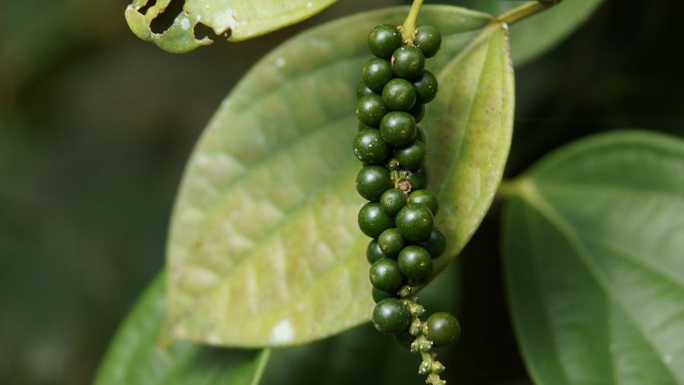Black Pepper Corns. Photo by Chris Kilham
Native to South India along the Malabar Coast, cultivated throughout the tropics, and found on virtually every restaurant table and in every family kitchen cupboard, black pepper, Piper nigrum, is the world’s most widely traded spice. Employed since antiquity when it was first carried across Asia on the backs of camels along the trade routes that connected Asia and Europe, black pepper occupies a distinguished place in commerce and cookery.
Black pepper is not to be confused with chile peppers, which are spicy fruits of pepper bushes whose flavor is imparted by a hot oil known as capsaicin. Instead, black pepper comes from “peppercorns,” which are fruits of a flowering vine, and which are spicy due to a natural compound known as piperine. Peppercorns are drupes, which means they are fruits which possess a large seed and a small amount of fruit flesh covering that seed. Black peppercorns, green peppercorns, pink and white pepper all come from the same plant and from the same little fruits, but are prepared differently. Piperine is found in both the seed and flesh of the small fruits.
The history of black pepper can be traced as far back as 1200 BC, when it was employed by the Egyptians as part of the embalming process, during which whole peppercorns were stuffed into the nostrils of the deceased. For the Persians, the Arabs, the Romans and eventually Europeans, black pepper was a precious item, highly valued for its capacity to transform the flavor of dull foods. The spice was also used as a substitute for currency. In the royal courts of Spain and Portugal, silver trays of whole black peppercorns were passed around between guests after dinner, in a manner similar to mints and other after-dinner morsels today.
As a traditional medicine, black pepper has been part of various systems. In India’s 5,000-year-old system of Ayurveda, black pepper is recommended for coughs, colds and sore throats. In other systems peppercorns have been used in the treatment of indigestion, heart disorders, insomnia, and a plethora of conditions including toothaches.
The spicy bite of pepper is due to the compound piperine. The piperine in pepper is best preserved when the spice is kept in a cool, dry place, out of direct exposure to sunlight. Whole peppercorns keep their spicy favor better than ground pepper, which makes pepper grinders valuable in terms of deriving the maximum flavor from this spice. To get the maximum pepper flavor, it is best to grind it right onto food.
The beloved characteristic flavor and aroma of pepper is due not only to the sharp bite of piperine, but to aromatic compounds in the little fruits, including cineole, alpha-pinene, alpha terpinene, alpha-terpineol, borneol, camphor, carvacrol, cinnamic acid, D-limonene, saffrole and other agents. This unique flavor and aroma is greatly influenced by the handling and storage of peppercorns.
Piperine, the sharp spicy compound in peppercorns, is potently antioxidant, antibacterial, anti-inflammatory, stimulating, and thermogenic, meaning that it accelerates the burn rate of calories. Piperine can also be irritating; eating excessive quantities of black pepper is not recommended. Piperine from pepper is currently used in some herbal formulas to improve the absorption of various herbs, and piperine is known to increase the absorption of various nutrients including B-vitamins and selenium.
Interestingly, a compound named picaridin, which is a synthetic analogue of piperine, is a highly effective insect repellant, and is used as a substitute for DEET, which can cause both skin irritation and occasional (rare) nerve damage. Picaridin is now widely available in popular insect repellants.
Today Vietnam is the largest producer of black pepper, followed by Brazil and Indonesia. Pepper, spicy, sharp, aromatic and a treasure since early civilizations, has earned an important spot in the culinary traditions of many nations, as a result of its piquant flavor and bright aroma. Hail pepper!


